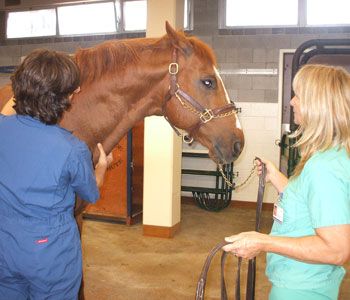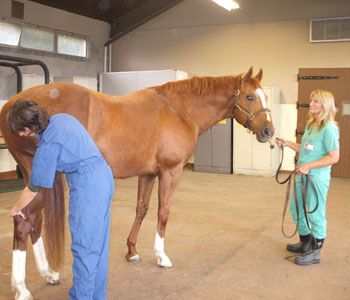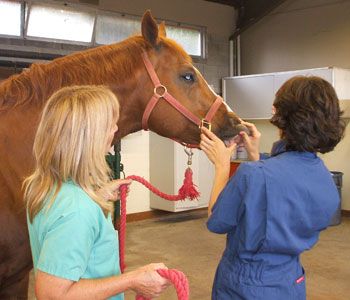Safety 101: 8 simple equine handling tips
Veterinary equine technicians: Follow these tips to keep yourself-and your team-from getting stepped on, stomped on, or kicked.

Dr. Monica Morganti (left) and veterinary technician Barbara Stewart work together on an equine patient. (Photo courtesy of Marika Pappagianis, RVT, VTS.)
Unlike happy and healthy horses accustomed to their owners riding them around the stable, at the racetrack, on a trail, or at a dressage event, a horse in a veterinary setting is in unusual surroundings and most likely in discomfort or pain. Then that same uncomfortable horse is approached and treated by people he's not familiar with. This sets up a situation that potentially threatens the veterinary team's safety.
“When I hire veterinary technicians to work with the horses, they must come with good horse-handling experience,” says Marika Pappagianis, RVT, VTS (LAIM), nursing manager at the Large Animal Clinic at UC Davis School of Veterinary Medicine in Davis, Calif. “Once they're here, we talk about working safely around horses during veterinary procedures. We try to prevent people from getting stepped on, kicked, stomped on, struck, bitten, thrown against the wall, and so on.” Here are safe horse-handling tips from Pappagianis and other equine veterinary technicians.
1. Approach with caution. When in a clinic, ambulatory, or hospital setting, you won't be familiar with most of the horses. So, for safety's sake, you must approach them from the front if possible, cautiously, in an easy manner, and continually monitor their responses.
If the horse is in a stall, as you walk in, he might spin around and turn his hind end towards you or he might pin you against the wall. How do you avoid this? “Entice them to come to you, maybe with a carrot or grain, so that the horse comes to you head first,” says Jane Tyrie, President of the American Association of Equine Veterinary Technicians and veterinary technician at the University of Pennsylvania School of Veterinary Medicine's New Bolton Center in Kennett Square, Pa.
Jennifer Struble, an animal health technician at the UC-Davis Equine Health Center in Davis, Calif., says that when you approach a horse that might be in pain due to lameness, leg injury, or colic, you should pay close attention to their facial expression and ears. “Come toward the shoulders, letting him know and see you coming and letting him smell your hand,” Struble says. “Normally when they're in pain, they're not apt to run away from you and stand fairly easily to put a halter on them.” If they are hard to catch, Struble says you might get assistance from another person to try to get the horse in a corner of the stall.
(Click here to continue to the next page.)

Veterinary technician Barbara Stewart holds the equine patient's head while Dr. Monica Morganti examines the horse's back legs. (Photo courtesy of Marika Pappagianis, RVT, VTS.)
2. Go from front to back. If you have to approach the patient's rear end for treatment, you should have someone handling his head, Tyrie says. “Approach the horse's shoulders, pet him, run your hand over his neck,” she says. “Continue to glide your hand over the patient's back as you proceed to the rear, so he knows that you're back there.” Once the horse is aware of your presence at his rear end, then it's easier to pick up a hind leg for a procedure.
On the flip side, never stand directly in front of the horse. Instead, stand to the side, close to the horse's body. This is especially important during certain procedures, such as placing a nasogastric tube.
3. Don't play both sides. “When working in tandem with a veterinarian, the most important thing is to be aware of the horse, aware of what he's doing, and to stay on the same side of the horse as the veterinarian during the procedure,” Tyrie says. “If the veterinarian is on the left side, you are on the left side. If the veterinarian moves to the other side, you move with him or her so both of you are always on the same side of the animal. If the horse then moves or jumps, he's going to move away from both of you, and both you and the veterinarian will be protected.” Another important tip: Turn the horses' head to the side where you and the veterinarian are working. This way, if the horse moves his hind end, it will move away from you.
(Click here to continue to the next page.)

Veterinary technician Barbara Stewart uses minimal restraint while Dr. Monica Morganti examines the horse's teeth. (Photo courtesy of Marika Pappagianis, RVT, VTS.)
4. Know how to hold your horses. “Our primary job is to protect the person who's working on the horse, be it a veterinarian or a fellow technician,” says Sheri Miller, LVT, a veterinary technician at Rood and Riddle Equine Hospital in Lexington, Ky. She says the veterinary technician is the primary person in charge of restraining the horse. “Our main concern is to keep the animal still for the procedure and keep the veterinarian safe,” Miller says.
The trick to restraint, according to Pappagianis: “I always tell technicians to start with the least amount of restraint possible and move from there. For example, there's an amazing amount of work you can get done on neonates by barely touching them as opposed to trying to ‘cowboy' them down and overpower them. It may simply take an arm around the foal's chest and one around the rump, or it may take much more. But I like to start with minimal and adjust as necessary.”
Elyse Rowley, MS, ICU Technician at Alamo Pintado Equine Medical Center in Los Olivos, Calif., agrees: “Some horses, adults and foals alike, respond much better to less restraint rather than more aggressive means of handling when they're acting up.”
Here's the proper order of restraint on an adult horse, from least to greatest, according to Pappagianis.
- Halter and lead rope
- Skin twitch
- Stud chain
- Handle twitch
- Lip chain
“Quite frankly I urge chemical sedation, depending on what the procedure is and what the problem is with the animal,” Pappagianis says. “We can't help animals if they're fighting us and are too agitated.”
5. Focus and communicate. “Once you have a horse restrained, you must keep it that way,” Miller says. “Knowing how horses respond, foreseeing anything that might happen, keeping your mind on the game, and paying attention to what's going on, are all critical skills for veterinary technicians.” she says. She limits distractions and stops people from walking through the room where they're treating horses. “We need to have total focus on that horse at that moment,” Miller says.
If you do lose control of a patient-or even suspect that you might-you need to immediately communicate this to whoever is working on the horse, she says. This allows veterinarians to get out of the way or ask a second person to help restrain the horse.
(Click here to continue to the next page.)

This veterinary technician and veterinarian stand on the same side while the veterinarian performs a flexion test. (Photo courtesy of Jane Tyrie.)
6. Create a barrier. If the horse is known for rearing up or striking, stand outside the stall and use the door as a shield. Hold the lead rope so that if the horse rears, the solid stall gate will protect you.
7. Be aware of body language. This helps you predict what you need to do to maintain your and your team members' safety. Monitor the horse's eyes and ears: Eyes white or ears pinned may signal fright, impending flight, and aggression. Also, pay attention to the patient's mouth to avoid being bitten. Also watch for stomping feet and a swishing tail, which may indicate pending aggression. As you work, be sure to pet the horse and softly talk to him to help keep him calm.
Always keep at least one hand on the horse's body so you can feel any movement coming. For example, if a horse is shying away during a procedure and you can feel which way he's moving, you'll be able to direct his body away from the veterinarian. Touch the horse gently somewhere before grabbing a leg, which may be startling.
If the horse is severely ataxic, be aware of his posture and feet rather than fixating on the procedure, such as a belly-tap. This way you'll notice if the horse looks like he's going to do something aggressive or lose his balance and fall on the personnel performing the procedure.
8. Develop understanding. “The key to being safe around the horses we work with is ‘reading' them,” Rowley says. “Horses get a sense about us just as we do about them, and if you approach the horse too slowly or too abruptly, the horse may not tolerate that. It's especially helpful when owners are honest about their horses' bad behaviors, but often the horses are brought in by haulers who aren't familiar with them. Then it's up to us to get a feel for how the horse is going to be as a patient.” This, coupled with all the tips, will help ensure your safety, the entire team's safety, and also the horse's safety.